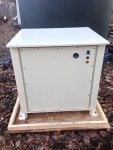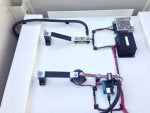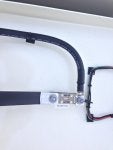Hello all,
I am hoping I can get some info./assistance/guidance from some of you kind and knowledgeable folks... I do realize this is an EV forum, but I know you can still give me good advice.
THE SHORT:
BALQON = NO USER MANUAL or USER GUIDE = NO COMMUNICATION = MY 27kwh LiFEPo4 Battery pack sitting outside for several months NOT hooked up = me freaking out about self discharge (which I didn't even know existed) and a possible 800lb. expensive brick!!!
THE LONG:
This past summer (2015) my wife and I refinanced our house, took out loans, and spent our life savings to pursue our mutual life-long dream of a full turnkey Solar scenario.
The goal was to get all the components in and then hire a local professional to put it all together and guide us through it all, including the use and maintenance.
After doing some comparisons of battery options I decided to go with LiFEPo4. I contacted Balqon, and Samra (CEO?) spent well over an hour on the phone with me and convinced me that was the route to go and that his company was the way to go.
We went through a Solar company to get 24 panels, mounts, a Schneider/Midnight Classic all-in-one wall of electronics and a 27kwh battery bank in an external enclosure, from Balqon.
Balqon took tons longer to ship than promised, after awful communication. Then, despite calls and emails DAILY from myself as well as from the company I bought it through, we still have yet to get a response. And all we were trying to do was get a User Manual or User Guide for the 27kwh battery pack. You know, "This is how you hook it up, Do this, Don't do this, This button does this, This is how to actually open it up, etc..."
Well, then there had been ridiculous and extensive problems and delays in getting the mounting in. (FedEx Freight basically ran over everything with a fork lift, then I get sent the wrong stuff, then they won't send the right stuff, then they want me to pay for the right stuff cause it's not what they were told to send, etc...)
So, as of today I now have all the components in. (Except any of the information I needed from Balqon, that is.)
While online last week doing some research I ran across people talking about self-discharge (which, again, nobody ever told me was even a thing) and how it could brick your battery. (I am aware of the BMS and it's self cut-off to prevent it getting too low, etc.) Well now I am FREAKING OUT!!! Due to all the calamity of errors and delays, the battery has been sitting outside untouched for several months! I don't know how much charge it came with, how to hook it up, nor how to operate it (because I never got a manual, nor did I have everything in to begin an install)
From the looks of things it will probably be this Spring until the panels are mounted and we are ready to actually hook up to it.
So, please, tell me, what do I do??? Assuming I hit the "On" button and it isn't dead, how on earth can I put a charge into it without all the solar panels hooked up to get it to last till the spring without bricking? Can I hook jumper cables up to it from my car for countless hours? Is there a way to hook up a generator directly to it without the wall of electronics? Can I plug into it from my house? I mean, I don't need to fill it up and worry about an over charge, I just need to keep it from dying.
Then, If I go to push the "On" button and nothing happens, or it is totally dead what options do I have?
Quite Sincerely,
Recent Newb
I am hoping I can get some info./assistance/guidance from some of you kind and knowledgeable folks... I do realize this is an EV forum, but I know you can still give me good advice.
THE SHORT:
BALQON = NO USER MANUAL or USER GUIDE = NO COMMUNICATION = MY 27kwh LiFEPo4 Battery pack sitting outside for several months NOT hooked up = me freaking out about self discharge (which I didn't even know existed) and a possible 800lb. expensive brick!!!
THE LONG:
This past summer (2015) my wife and I refinanced our house, took out loans, and spent our life savings to pursue our mutual life-long dream of a full turnkey Solar scenario.
The goal was to get all the components in and then hire a local professional to put it all together and guide us through it all, including the use and maintenance.
After doing some comparisons of battery options I decided to go with LiFEPo4. I contacted Balqon, and Samra (CEO?) spent well over an hour on the phone with me and convinced me that was the route to go and that his company was the way to go.
We went through a Solar company to get 24 panels, mounts, a Schneider/Midnight Classic all-in-one wall of electronics and a 27kwh battery bank in an external enclosure, from Balqon.
Balqon took tons longer to ship than promised, after awful communication. Then, despite calls and emails DAILY from myself as well as from the company I bought it through, we still have yet to get a response. And all we were trying to do was get a User Manual or User Guide for the 27kwh battery pack. You know, "This is how you hook it up, Do this, Don't do this, This button does this, This is how to actually open it up, etc..."
Well, then there had been ridiculous and extensive problems and delays in getting the mounting in. (FedEx Freight basically ran over everything with a fork lift, then I get sent the wrong stuff, then they won't send the right stuff, then they want me to pay for the right stuff cause it's not what they were told to send, etc...)
So, as of today I now have all the components in. (Except any of the information I needed from Balqon, that is.)
While online last week doing some research I ran across people talking about self-discharge (which, again, nobody ever told me was even a thing) and how it could brick your battery. (I am aware of the BMS and it's self cut-off to prevent it getting too low, etc.) Well now I am FREAKING OUT!!! Due to all the calamity of errors and delays, the battery has been sitting outside untouched for several months! I don't know how much charge it came with, how to hook it up, nor how to operate it (because I never got a manual, nor did I have everything in to begin an install)
From the looks of things it will probably be this Spring until the panels are mounted and we are ready to actually hook up to it.
So, please, tell me, what do I do??? Assuming I hit the "On" button and it isn't dead, how on earth can I put a charge into it without all the solar panels hooked up to get it to last till the spring without bricking? Can I hook jumper cables up to it from my car for countless hours? Is there a way to hook up a generator directly to it without the wall of electronics? Can I plug into it from my house? I mean, I don't need to fill it up and worry about an over charge, I just need to keep it from dying.
Then, If I go to push the "On" button and nothing happens, or it is totally dead what options do I have?
Quite Sincerely,
Recent Newb

























